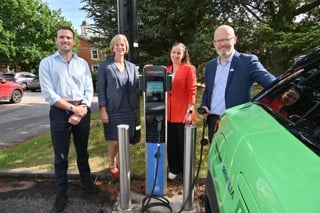Crashes involving at-work drivers are forecast to reduce as employers benefit from a new online benchmarking tool being launched today (Wednesday, March 2).
The free to use Fleet Safety Benchmarking tool enables employers across the public, private and voluntary sectors to measure their at-work road safety performance against a wide-range of other organisations.
Fleet News revealed last month that the Fleet Safety Benchmarking tool is being delivered as a contribution to the work of the Occupational Road Safety Alliance (ORSA) by the team behind the Driving for Better Business (DfBB) campaign with backing from the Department for Transport and in collaboration with a range of fleet-related organisations.
Those organisations include the Freight Transport Association’s Van Excellence programme, global provider of driver safety management solutions Interactive Driving Systems, RoSPA and TRL (Transport Research Laboratory) as well as Fleet Forum, an international interagency association whose focus includes sharing concerns about road safety and fleet efficiency. Support has also come from the Australian National Road Safety Partnership Programme.
Measuring both processes and outcomes, the tool is suitable for use across a comprehensive range of vehicle types including company cars, motorcycles, light commercial vehicles, HGVs, minibuses, buses and ‘grey fleet’ vehicles - privately-owned cars driven on business trips.
The tool uses 30 questions to examine an employer’s current practices across six key areas:
Road safety management policy; organisational leadership and culture; journey and mobility management; driver recruitment, induction, management and wellbeing; vehicle selection, safety, management and security; and corporate, community and supply chain road safety.
Having inputted data, a report will provide question by question responses and feedback including questions scored and reported against averages determined from other users’ information, data tables and graphs based on each of the six sections of gap analysis.
Data analysis will provide information on collision rates per vehicle and per one million kilometres driven as well as by vehicle and incident type and location.
After analysing how a specific fleet compares with other tool users, registered participants will be able to access a wealth of resources to enable existing policies to be updated and new risk management solutions introduced. That includes links to best practice and case studies, surgery and good practice request processes and conference call discussions.
The tool will be unveiled at today’s Royal Society for the Prevention of Accidents’ (RoSPA) Road Safety Conference by Melvyn Hodgetts, DfBB campaign manager.
He said: “Fleet decision-makers will know the risk management solutions they have implemented and their outcomes. But is that performance good so momentum can be maintained or can results be improved? Benchmarking will provide the answers.
“Fleet safety is most likely to be improved by the introduction of an integrated set of measures based on the safety culture within an organisation and benchmarking is one of the most effective ways of achieving improvements to road safety in a corporate setting.”
DfBB calculates that of the 1,775 people killed on Britain’s roads in 2014, the most recent year for which Department for Transport data is available, 547 (30%) died as a result of someone driving for work. Additionally, of the 22,807 road users seriously injured in 2014, 5,168 (22%) were at-work driving related.
The new tool is a significant enhancement of Interactive Driving Systems’ Fleet Safety Gap Analysis, an online 10-question solution that allows fleets to benchmark their own responses against those of currently almost 1,400 participants providing an insight into the safety of an organiation’s vehicles and drivers and how they rank against others.
Interactive Driving Systems’ data suggests that among the 12 most active benchmarking participants, representing 170,000 drivers and 80,000 vehicles, more than £11 million has been saved in direct cost reductions over three years as incident claim rates have reduced.
Will Murray, research director at Interactive Driving Systems, said: “Benchmarking is the continuous process of measuring products, services or practices against industry leaders and others to gain new insights and identify improvements.
“It can focus on process - policies and procedures - and outcomes - key performance indicators on crash data and costs.”
He continued: “Using the tool will help make organisations aware of the business and operational benefits of good work-related road safety management and engage those which are not already committed through a mechanism to compare processes and performance and an awareness of the help, resources and advice available.
“Benchmarking safety performance against others is important for many reasons. They include identifying what peers in the fleet industry are doing enabling ‘me too’ outcomes;
identifying what is realistic without having to reinvent the wheel; helping make the business case for safety internally as what gets measured, gets bettered; and provides greater corporate confidence in terms of health and safety compliance regulations.”
Fleet industry welcomes Fleet Safety Benchmarking tool launch
BT, which operates 33,000 company cars, vans and other commercial vehicles, has been in the vanguard of occupational road risk management for many years and is a DfBB fleet champion.
A long-time user of Interactive Driving Systems’ gap analysis tool, Scott Titmus, BT Fleet customer relationship manager, said: “Many fleets are faced with the same issues and through benchmarking you realise you are not alone in tackling risk areas.”
He points to developing BT Fleet’s mobile phone policy, including tyre wear and tear in driver risk profiles and currently a refreshing of the company’s long-established driver training policy as areas where benchmarking has actively provided information to enabled improvements to be introduced.
Titmus said: “Many fleets may take the view that if it’s not broke then leave well alone. However, with risk management it is vital to know whether your performance is exceptional, average or bad. Benchmarking delivers that overview.”
Irrespective of fleet size, vehicle type and business sector, Titmus points out that sharing best practice across fleets involved in benchmarking enables employers to ‘cherry pick’ ideas and target solutions.
He said: “The biggest benefits are from benchmarking against businesses in a similar industry, operating similar vehicle types or similar work patterns. However, ultimately everyone can learn from each other.
“Benchmarking provides robust data and the argument for change to enable further risk-related improvements to be made.”
The initiative is also backed by Volvo Car UK, which works closely with DfBB to promote the message that safer cars, safer drivers and better management of those who drive for work can reduce business costs and make organisations more efficient and profitable
Kay Saunders, campaign manager - business sales, Volvo Car UK, said: “Safety is at the core of Volvo Car UK’s values. We believe in building cars around people and for people. A business has to protect its employees and everyone else it comes into contact with and good fleet safety management is vital to achieving that.
“A safe car is not enough, it also has to be about how a business manages safety and how drivers behave while on business. Benchmarking fleet safety has to be the start of the process to understand where you are today and to then be able to plan to move forward and improve for the benefit of all, while also gaining financial business benefits.”
Insurance giant Zurich has its own gap analysis tool and Andy Price, practice leader - EMEA, motor fleet, was a member of the working party that has been instrumental in the development and launch of the new benchmarking tool.
He said: “Many fleet customers want to know from an insurance perspective how their fleet is performing versus other organisations. However, there are so many variables - type of cover, type of vehicles, where vehicles are being driven, driver profile and many others - it is almost impossible to provide that information.
“Benchmarking how an organisation manages risk provides an insight into how a company manages its work-related road risk when compared with the rest of the market. The online tool identifies where organisations are doing well and where there are opportunities to improve.
“The risks are that a business discovers it is doing well and then becomes complacent. However, there is always scope for improvement that will continue to reduce both the total cost of risk and the total cost of ownership.”
Benchmarking, while identifying gaps in managing work-related road safety, will not identify solutions. Therefore, said Price: “It is important for fleets to reach out to their insurer, DfBB or other experts to implement solutions.
“But benchmarking is a good process for organisations to go through to improve their work-related road risk. Irrespective of size of fleet, type of vehicle and business/industry sector, gap analysis will deliver important information that can be acted on to improve safety and cut costs.”
Acknowledging that it can take time to both implement solutions and for them to have an impact, Price recommends fleets complete a benchmarking exercise every two years.
However, he added: “Fleet decision-makers can quickly see whether vehicle and driver risk is reducing by analysing the frequency and severity of their collisions and claims.”
To use Fleet Safety Benchmarking tool, go to www.fleetsafetybenchmarking.net.



















Login to comment
Comments
No comments have been made yet.